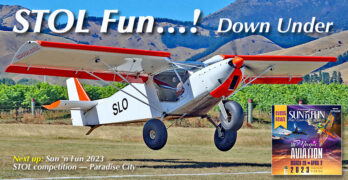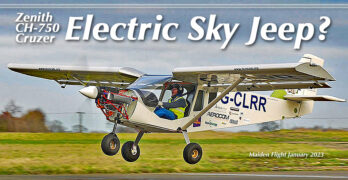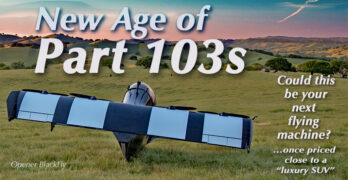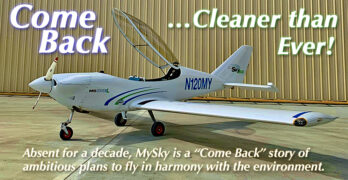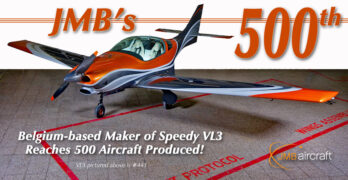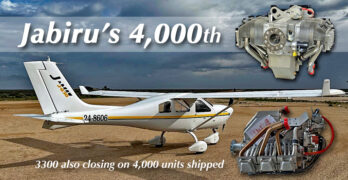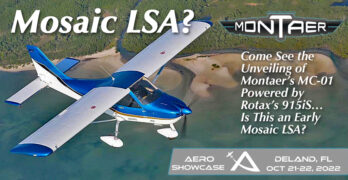A winning airshow attraction over the last few years has been STOL competitions. STOL stands for Short Takeoff and Landing. Believe me, these pilots totally obsess over “short.”
You truly need to see these performances to believe what determined pilots in suitable aircraft can do. I encourage all to come on down to sunny Florida for Sun ‘n Fun 2023 and check out the action in Paradise City (formerly the “Ultralight/Lightplane Area” and now badged as “Light Planes“).
Like its counterpart at AirVenture in the Fun Fly Zone (also the former Ultralight Area), crowds can get close enough to see the STOL performances in great detail. Usually you have to arrive early enough to get a place at the fence. I’ve seen spectators 10-deep at both events.
Paradise City hosts Sun ‘n Fun’s “other” runway, a grass strip that’s been steadily improved enough that the local Lakeland Aero Club, associated with the onsite high school, can and does conduct flight operations during the 51 weeks of the year when the show isn’t happening.
Search Results for : Flight Design
Not finding exactly what you expected? Try our advanced search option.
Select a manufacturer to go straight to all our content about that manufacturer.
Select an aircraft model to go straight to all our content about that model.
Should Your Out-Back, Off-Airport “Sky Jeep” Go Electric? Here’s One Answer…
Zenith’s headline read: “All-electric Zenith ‘Sky Jeep’ completes first flight, with plans to transport doctors and medical supplies in remote areas of the world.” Several aviation publishers jumped on the news* from light kit-built market leader, Zenith Aircraft.
I’m curious what you think of (1) electric propulsion on any aircraft and (2) electric power for an aircraft used, let’s say, for exploring. If you have an opinion and care to share it, use the comment feature.
To date, most electric-propulsion entries have been sleeker designs. Pipistrel has been a leader in this class; they got their start building sailplanes and motorgliders and never lost their preference for clean, smooth shapes. Many others also participated (nearby images).
Bye Aerospace’s eFlyer continues its long path toward the market. This development company based its aircraft on Arion’s Lightning airframe, a smart choice as Lightning is so smoothly constructed. This article describes what was then called Sun Flyer.
Invasion of the Part 103 Multicopters — Surveying 5 Entries, All “No Pilot License Required”
These new-millennia flying machines have inspired multiple names. While an eventual winner is determined, a common handle seems to be the rather awkward “eVTOL” — for electric vertical takeoff and landing. A range of abbreviations are also used: UAV, UAM, UAS, autonomous aircraft, and several others. I like multicopter — because all of them involved multiple propellers doing the lifting.
Most commonly, you hear “drone.”
Yet “drone” is further confusing because we haven’t separated crewed aircraft from uncrewed aircraft and this is a major distinction. FAA has also made this separation, so for this article, I will only speak of crewed aircraft, that is, a flying machine with a pilot using controls to direct its flight. In addition, I will also stick solely to single place aircraft that can theoretically qualify as a legitimate Part 103 ultralight vehicle.
Let me first extend a quick thanks to IEEE’s Spectrum magazine for making me aware of entries I’d missed.
It Was a Very Good Year — Icon Is Back on Heading with Their A5 LSA Seaplane
Some might say Icon Aircraft has experienced a rather turbulent flight. The company came off the starting line boldly with splashy marketing including an immense, fancy tent right at the entrance to AirVenture. Each year at Oshkosh, the company hosted an annual party with special features and free drinks. It became a must-attend event for those lucky enough to get an invitation.
When A5 was finally accepted by FAA as a Special LSA, the company shrewdly arranged to get on the cover and be the lead article in the same month of American aviation’s top three magazines (by circulation): Flying magazine, AOPA Pilot, and EAA Sport Aviation. I’ve been around and observing aviation publishing for a few decades and I’d never see such a triple play before. These magazines are friendly to each other but nonetheless compete vigorously. The rarely (never?) want the same cover story as their rivals. Icon accomplished this without spending a dime advertising with the publications.
Come Back… Cleanly! MySky Returns with Plans to Make Flying Friendlier
Once upon a time, I was able to report three or more new Special Light-Sport Aircraft every month. That was more than a decade back when the pace of new arrivals seemed faster than a rocket parachute deployment. Lots of airplane developers from all over the globe wanted a piece of this promising LSA action with its greater freedoms and breathtaking pace of innovation. New models were announced with regularity.
For the past few years that torrid pace slowed… just as it has in every other industry I’ve examined. However, in aviation it is uncommon for a good airplane to actually disappear forever. Designs worth their avgas often manage a come-back, a term meant to show a return to market for a flying machine some may have written off earlier.
Here is such a story.
MySky MS-One
From the day I laid eyes on it, I liked the tandem seating, comfortable cockpit, and sturdy construction of MySky’s MS-1 or MS-One.
JMB Aircraft Delivered #500 of their Blazing-Fast VL3 Light Aircraft + Evolution News
Fifteen years ago, in 2007, Guisset brothers Jean-Marie and Jean-Baptiste were dealers in France and Belgium for a company then known as Aveko. Driven by a passion for flying that started when they were only fourteen years old, the brothers were successful enough that at one point they could claim to have sold more than 85% of the aircraft produced by Aveko.
Aircraft seen in nearby images is the VL3, a plane formerly designed by Vanessa Air and produced by Aveko. Americans first came to know a variation of this model as the Gobosh G700S although that faded about the time JMB took over production. Some years went by with no U.S. presence for the European low-wing aircraft.
Five years later, in 2012, the Guisset brothers’ acquired Aveko. Shortly after, they started to upgrade the aircraft, pushing the aircraft to fly faster (article). They also upgraded the interior; see current state-of-design in a nearby image.
Jabiru Engines Approaching 8,000 Engines Produced — Plus, Our List Reporting Every LSA Engine
When I was a kid, I was a New York Yankees baseball fan. Why? I’d never been to New York; I lived in the midwest. I loved the baseball team because they won a lot. The saying way back then was, “The American League battle isn’t to determine who wins, but which team might come in second.” Everybody knew the Yankees would win again. (As I said, this was some time back in history.)
In light aviation, we have a roughly similar situation. Rotax provides somewhere around 70-80% of all engines for aircraft in the light aircraft space globally. The remaining 20-30% is divided between Continental or Titan, Jabiru, ULPower, and a growing collection of converted auto engines (though the latter, without ASTM approval, are used only on kit aircraft or ELSAs).
US Sport Planes owner Scott Severen, who represents Jabiru in America, declared for the Australian manufacturer, “The 4,000th Jabiru 2200 four-cylinder, 81-horsepower engine [was] recently produced at the Jabiru facility.” And, he added, “The 3300 engine [series is] fast approaching this number, too.”
So, Jabiru may not be #1, but the “down-under” company achieved a significant benchmark when they shipped number 4,000 of the 2200 series.
Big, Beautiful, Powerful — The Highly Finished Montaer MC01 with Rotax 915iS
Pilots love airplanes (duh!). Pilots also love engines, especially when they are truly powerful. So, perhaps Brazilian manufacturer Montaer made a market-savvy move by moving quickly to incorporate Rotax’s most potent engine, their 915iS producing 141 horsepower in a turbocharged and intercooled package. The result of Bruno de Oliveira‘s design work is MC01 915 as seen in the nearby photos and in more detail in the video below.
Other powerful engines are available, for example, the even-higher-horsepower Titan from Continental Aerospace. These powerplant designs are sharply different because the Rotax uses a smaller displacement and is physically more compact. The 9-series is also significantly less noisy and it boasts the latest technology from an engine builder cranking out thousands of engines a year (when counting the many non-aircraft engines the Austrian company makes).
I wrote that Bruno moved quickly. That’s because this is a new model, first introduced to Americans only last year.
Made in America — The Affordable Ultralight Formerly Known As Zigolo Mg21
At airshows throughout 2022, I repeatedly spoke to pilots interested in ultralights, the true Part 103 variety. I continue to be impressed by two apparent facts.
First, among the better-informed recreational pilot population, virtually all know what a Part 103 ultralight is but most think they remain a small percentage of the aircraft being sold to pilots each year. Many also think a legitimate three-axis Part 103 is no more than a fantasy — one critique is that most fixed-wing 103 entries exceed allowed weight.
Secondly, the less-well-informed general pilot population has heard of Part 103 but often believe those aircraft mostly disappeared back in the last century and are only seen rarely these days.
Both could not be more wrong.
In numerous conversations, I’ve expressed my belief that Part 103 ultralights sell at approximately the rate of new Light-Sport Aircraft. Most folks find that hard to believe. I understand but this reveals how invisible these flying machines tend to be.
First-Ever Montaer MC01 915iS to Debut at Season-Finale Aero Showcase This Weekend
When I asked “Mosaic LSA?” in the lead image of this article, was I simply being provocative? Or, is the soon-to-be-debuted Montaer MC01 with Rotax 915iS a forecast of what is to come with Mosaic?
Hopefully the title did get your attention but it asks a legitimate question for buyers of new potentially-Mosaic-compliant Light-Sport Aircraft.
The reason I feel this way is not merely the 141-horsepower engine Montaer designer Bruno Oliveira installed on the nose of his three-door LSA (see earlier review, before 915).
A more significant reason is that this airplane is one of several that may be able to re-declare compliance and get a substantial weight increase. It will already have a powerful-enough engine to lift a heavier load.
So, buyers of this airplane (and I repeat, MC01 will not be the only such choice) may be able to acquire a present-day 1,320-pound LSA and later get it bumped to perhaps 1,600-1,700 pounds, maybe more.
- « Previous Page
- 1
- …
- 51
- 52
- 53
- 54
- 55
- …
- 147
- Next Page »


